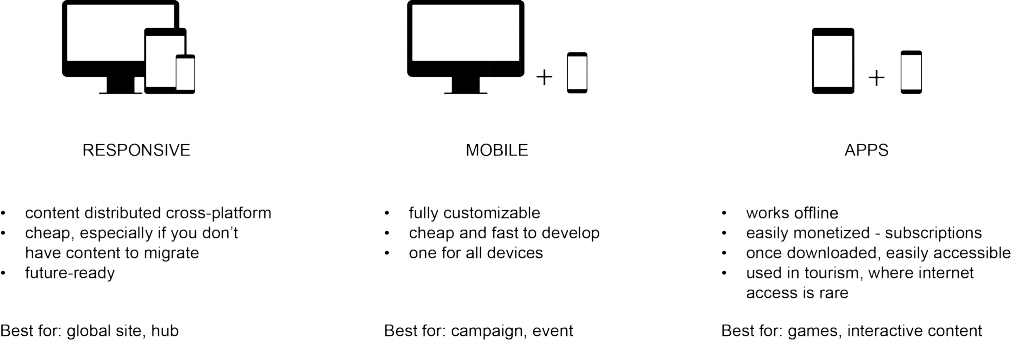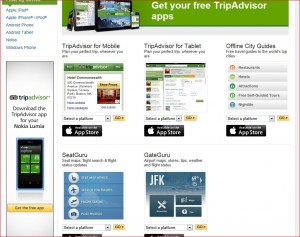There is no question about it; every business needs a mobile strategy (read our previous posts on strategically building responsive websites and developing content for those on the go). But when it comes to development, all of them face the question: which one? Is it better to follow the trend and rebuild the site in responsive design, quickly add a separate mobile site, or build an application based on specific platforms?
All of the different strategies have their pros and cons; therefore, evaluating your available resources and the needs of your users becomes a must. Otherwise, you may end up draining your budget on mobile strategy and realizing too late that the solution you choose doesn’t reach your end users.
Unfortunately, there isn't one method which works everywhere, and it may be best to work with several solutions at once, but the following should give you an idea about what to consider and where to start.
Responsive
If your web analytics shows a significant amount of mobile traffic but it seems that your on-the-go customers aren't finding what they’re looking for, chances are you need to start building a responsive site. This guarantees that anybody with an average Internet access and a browser-enabled device will find all the information they need… fast.
Whether your simple website displays static information, some pictures, videos and blog posts, or you have a more complex site, a responsive website will be the option for you. Designing your website to adapt may take time, but it will be a solid base, which is ready for future devices as well.
If your users and locked content is bigger than the average, e-commerce is your main activity, and you want to cater to users without constant access to the Internet, then adding a mobile site or a platform specific app may work better for you.
Mobile site
If you have invested a big amount of time and resources into having an extensive static website (with lots of content, flash animations, large photo galleries, 24h live customer service chat, and a host of other interactive components), a separate mobile site is often the fastest and cheapest approach to be added to your existing website.
With an additional mobile website, you will be able to serve your emerging mobile users with information that you can fully optimize for smaller screens. Plus, you can choose to add only the information that your mobile users are interested in (based on your website analytics). All this while using the mobile functions of HTML5 such as localization and phone number recognition.
Take a look at what Adidas has achieved with the help of their mobile site.
Another benefit of having a mobile site comes when you have an offline campaign or event. Besides complementing your social activities and making your content shareable across all platforms, it also helps by providing a better response rate.
Let's say you have posters about a new product or cause. To find out more or to take advantage of the offer, the audience needs to go to your website. Most of the responses you trigger will be made on mobile devices, as most people will want to instantly learn more. Without a mobile site, your audience may forget about your site and call to action by the time they get home.
Native apps
If you have a strong interactive feature that's contextually aware of the user's environment, you probably should choose to develop an app. Apps are great for bringing personalized information to devices, so if you have a big database, lots of returning users, interactive content or users with limited access to the internet, this is your best choice.
Businesses primarily find apps appealing because it’s the only way to have their brand on mobile app stores. Added benefits include not necessarily needing Internet access to run and codes that can be written for each mobile platform (iOS, Android, Blackberry, Windows, etc.) or having an "app shell" (which uses HTML, CSS and Java).
Magazines and newspapers are examples of businesses that usually have several native apps on various platforms to monetize and distribute their content. But besides apps, most of them also have either a mobile specific or a responsive site that caters to the audience browsing on their mobile devices.
The downside of developing native apps is that it can get costly, particularly if you want to reach users on different platforms. You may end up hiring a developer for each operating system and maybe even having to enhance and maintain several updates of each release as well. This is why it is important to know what device is utilized most by your audience so you can opt to develop just one app.
Caption: TripAdvisor’s app uses the device’s GPS; its content is also available offline and can be personalized.
On the upside, with apps, you can fully exploit the features and the environment – if you are planning to create a game, an interactive campaign using QR-code hunting, or augmented reality elements – then you can fully engage your audience and deliver a rich experience, which is great for trengthening your brand.
Not finding what you need?
Keep in mind that the solutions aren't restrictive, they are able to work together smoothly, delivering the best possible experience and fastest information for every device, every screen, everywhere.
Get in touch with us if you have a great project and are having trouble deciding which mobile/online strategy to use. We can help by analyzing your content, your end users, and giving you a personalized online presence.













